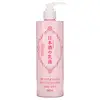What's inside
What's inside
 Key Ingredients
Key Ingredients

 Benefits
Benefits

 Concerns
Concerns

 Ingredients Side-by-side
Ingredients Side-by-side

Water
Skin ConditioningParaffinum Liquidum
EmollientGlycerin
HumectantCarbomer
Emulsion StabilisingPotassium Cetyl Phosphate
EmulsifyingPhenoxyethanol
PreservativeCetyl Alcohol
EmollientSodium Polyacrylate
AbsorbentCaprylyl Glycol
EmollientHydrogenated Palm Glycerides
EmollientSodium Hydroxide
BufferingButyrospermum Parkii Butter
Skin ConditioningDisodium EDTA
Avena Sativa Kernel Oil
Skin ConditioningMagnesium Aspartate
Skin ConditioningZinc Gluconate
Skin ConditioningCopper Gluconate
Skin ConditioningWater, Paraffinum Liquidum, Glycerin, Carbomer, Potassium Cetyl Phosphate, Phenoxyethanol, Cetyl Alcohol, Sodium Polyacrylate, Caprylyl Glycol, Hydrogenated Palm Glycerides, Sodium Hydroxide, Butyrospermum Parkii Butter, Disodium EDTA, Avena Sativa Kernel Oil, Magnesium Aspartate, Zinc Gluconate, Copper Gluconate
Water
Skin ConditioningGlycerin
HumectantParaffinum Liquidum
EmollientTriethylhexanoin
MaskingRice Ferment Filtrate
Skin ConditioningGlutamic Acid
HumectantArginine
MaskingLeucine
Skin ConditioningGlycine
BufferingCeramide EOP
Skin ConditioningCeramide NP
Skin ConditioningCeramide AP
Skin ConditioningPlacental Protein
HumectantArbutin
AntioxidantDipotassium Glycyrrhizate
HumectantCholesterol
EmollientPhytosphingosine
Skin ConditioningSodium Lauroyl Lactylate
EmulsifyingPEG-9
HumectantDimethicone
EmollientPEG-20 Sorbitan Isostearate
EmulsifyingCarbomer
Emulsion StabilisingXanthan Gum
EmulsifyingDisodium EDTA
Phytic Acid
Behenyl Alcohol
EmollientPotassium Hydroxide
BufferingSilver Oxide
AntimicrobialPhenoxyethanol
PreservativeParfum
MaskingAcrylates/C10-30 Alkyl Acrylate Crosspolymer
Emulsion StabilisingWater, Glycerin, Paraffinum Liquidum, Triethylhexanoin, Rice Ferment Filtrate, Glutamic Acid, Arginine, Leucine, Glycine, Ceramide EOP, Ceramide NP, Ceramide AP, Placental Protein, Arbutin, Dipotassium Glycyrrhizate, Cholesterol, Phytosphingosine, Sodium Lauroyl Lactylate, PEG-9, Dimethicone, PEG-20 Sorbitan Isostearate, Carbomer, Xanthan Gum, Disodium EDTA, Phytic Acid, Behenyl Alcohol, Potassium Hydroxide, Silver Oxide, Phenoxyethanol, Parfum, Acrylates/C10-30 Alkyl Acrylate Crosspolymer
 Reviews
Reviews

Ingredients Explained
These ingredients are found in both products.
Ingredients higher up in an ingredient list are typically present in a larger amount.
Carbomer is a polymer of acrylic acid. Its main role is to create a gel consistency.
A high amount of carbomer can cause pilling or balling up of products. Don't worry, most products contain 1% or less of carbomer.
Disodium EDTA plays a role in making products more stable by aiding other preservatives.
It is a chelating agent, meaning it neutralizes metal ions that may be found in a product.
Disodium EDTA is a salt of edetic acid and is found to be safe in cosmetic ingredients.
Learn more about Disodium EDTAGlycerin is already naturally found in your skin. It helps moisturize and protect your skin.
A study from 2016 found glycerin to be more effective as a humectant than AHAs and hyaluronic acid.
As a humectant, it helps the skin stay hydrated by pulling moisture to your skin. The low molecular weight of glycerin allows it to pull moisture into the deeper layers of your skin.
Hydrated skin improves your skin barrier; Your skin barrier helps protect against irritants and bacteria.
Glycerin has also been found to have antimicrobial and antiviral properties. Due to these properties, glycerin is often used in wound and burn treatments.
In cosmetics, glycerin is usually derived from plants such as soybean or palm. However, it can also be sourced from animals, such as tallow or animal fat.
This ingredient is organic, colorless, odorless, and non-toxic.
Glycerin is the name for this ingredient in American English. British English uses Glycerol/Glycerine.
Learn more about GlycerinParaffinum Liquidum is also known as liquid paraffin. It is a type of highly refined mineral oil.
Like other oils, Paraffinum Liquidum has emollient properties. Emollients help soothe and soften the skin. By creating a barrier to trap moisture within, emollients help keep your skin hydrated.
Paraffinum Liquidum does not irritate the skin and is non-comedogenic.
Learn more about Paraffinum LiquidumPhenoxyethanol is a preservative that has germicide, antimicrobial, and aromatic properties. Studies show that phenoxyethanol can prevent microbial growth. By itself, it has a scent that is similar to that of a rose.
It's often used in formulations along with Caprylyl Glycol to preserve the shelf life of products.
Water. It's the most common cosmetic ingredient of all. You'll usually see it at the top of ingredient lists, meaning that it makes up the largest part of the product.
So why is it so popular? Water most often acts as a solvent - this means that it helps dissolve other ingredients into the formulation.
You'll also recognize water as that liquid we all need to stay alive. If you see this, drink a glass of water. Stay hydrated!
Learn more about Water